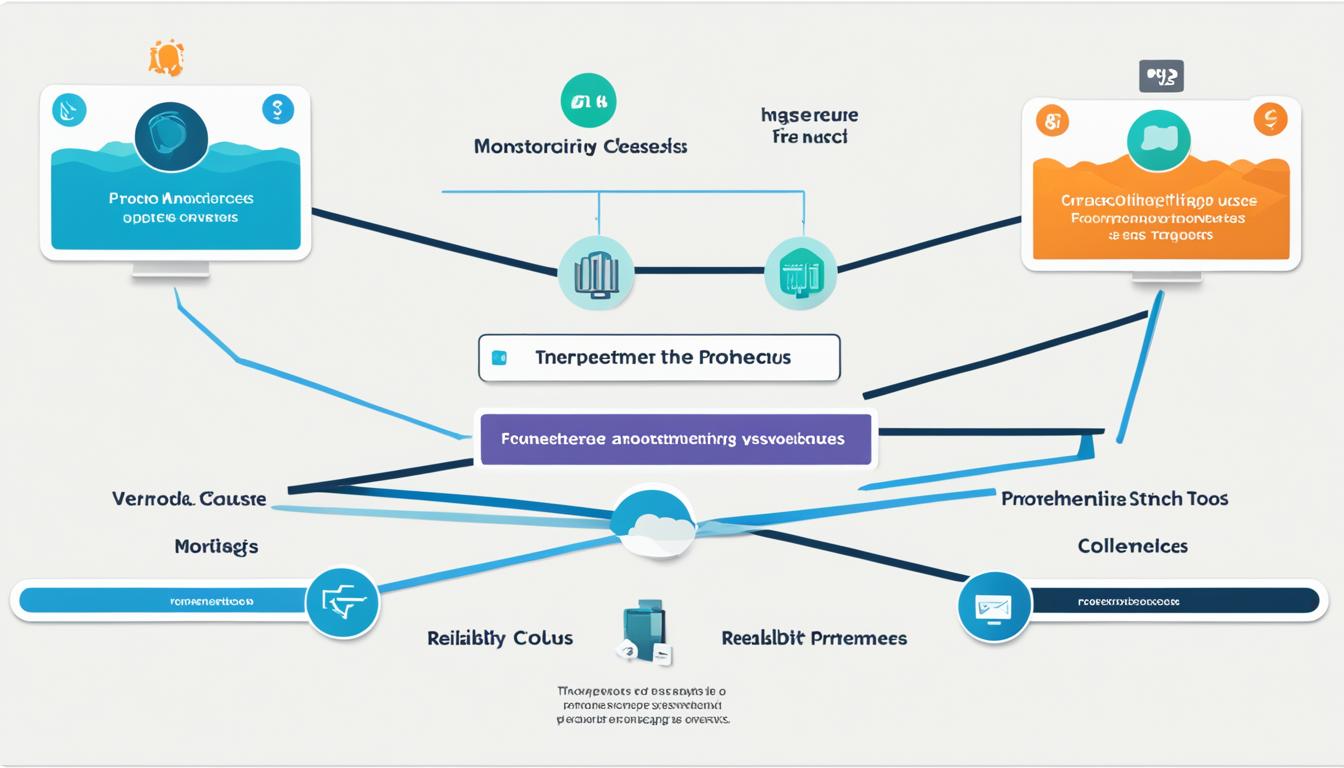Nagios vs. Prometheus: My In-Depth Comparison
When it comes to monitoring tools for your IT infrastructure, there are a plethora of options available. However, two popular open-source monitoring software, Nagios and Prometheus, stand out from the crowd. Both tools offer performance monitoring solutions and alerting systems, but which one is the best for your DevOps environment?
In this in-depth comparison, I dive into the features, usability, architecture, and more of Nagios and Prometheus to help you make an informed decision. So, let’s get started and uncover the truth behind these resource monitoring platforms!
Key Takeaways:
- Nagios and Prometheus are popular open-source monitoring tools for IT infrastructure.
- Both tools offer performance monitoring solutions and alerting systems.
- Nagios focuses on network monitoring, while Prometheus specializes in time series data collection and analysis.
- The architecture, data model, and usability of Nagios and Prometheus differ.
- Consider your specific needs and requirements to choose the best monitoring tool for your DevOps environment.
Introduction
Monitoring tools play a crucial role in ensuring the optimal performance of IT infrastructure. With the rise of DevOps practices, the demand for open-source monitoring software has increased. Nagios and Prometheus are two popular options in the market that offer resource monitoring platforms. In this article, we will compare these tools to help you make an informed decision.
When it comes to monitoring tools comparison, open-source monitoring software provides a cost-effective solution for businesses looking to monitor their IT infrastructure. These tools offer a range of features and functionalities that allow organizations to monitor various aspects of their systems, such as network devices, server performance, and application health.
In this review, we will focus on two widely used open-source monitoring software options: Nagios and Prometheus. Both of these tools have their own strengths and weaknesses, and understanding their differences will help you choose the right tool for your organization’s needs.
Throughout this comparison, we will evaluate key aspects of these monitoring tools, including their performance monitoring solutions, alerting systems for IT infrastructure, and overall usability. By the end of this article, you will have a clearer understanding of which tool is the best fit for your resource monitoring needs.
Features and Functionality
Nagios and Prometheus offer a comprehensive range of features and functionality, making them powerful performance monitoring solutions for IT infrastructure and network monitoring tools. Each tool caters to different aspects of monitoring and alerting, providing unique benefits for server monitoring software.
Nagios: Comprehensive Network Monitoring
Nagios excels in its ability to monitor various network devices and services, making it a top choice for organizations with complex network monitoring needs. Its extensive capabilities encompass monitoring network devices, such as routers and switches, as well as network services, like HTTP, FTP, and DNS. With Nagios, you can stay on top of the performance and availability of critical network components in real-time.
“Nagios provides comprehensive network monitoring capabilities, allowing you to monitor various network devices and services.”
Another notable feature of Nagios is its flexible plugin architecture. This allows users to extend the functionality of the tool by integrating additional plugins. The plugin ecosystem enables users to monitor specific applications, protocols, and services that may be unique to their IT infrastructure, ensuring the monitoring solution is tailored to their specific requirements.
Prometheus: Advanced Time Series Data Analysis
Prometheus distinguishes itself through its focus on time series data collection and advanced metrics analysis. It provides a rich query language for analyzing and graphing metrics, making it an excellent choice for businesses that require in-depth insights into their system’s performance.
“Prometheus focuses on time series data collection and provides a rich query language for analyzing and graphing metrics.”
One of Prometheus’ standout features is its built-in alerting system. It allows users to set up configurable alerts based on specific metrics, ensuring that any deviations or anomalies in the system’s performance are immediately detected and acted upon. This proactive approach to alerting helps IT teams address potential issues promptly, minimizing downtime and improving overall system stability.
In addition to its built-in alerting, Prometheus supports various integrations with other monitoring tools and systems. These integrations enable users to consolidate their monitoring efforts and gain a holistic view of their IT infrastructure. Prometheus is particularly well-suited for businesses operating in DevOps environments, where quick and accurate insights into system performance are crucial.
Data Model and Storage
The data model and storage mechanisms used by monitoring tools are vital factors in determining their performance and scalability in resource monitoring platforms. Nagios employs a host-based data model, where each host can have one or more services, and stores data in flat files. On the other hand, Prometheus utilizes a time series data model and saves data in its local file per time series, providing greater flexibility and granularity in data storage.
While Nagios’ flat file storage is straightforward and efficient, it may not offer the same level of adaptability as Prometheus’ time series data model. The latter’s approach allows for easy manipulation and analysis of data, making it a preferred choice for users who require advanced metrics analysis.
With Nagios’ host-based data model, a single host may have multiple services associated with it, enabling a comprehensive monitoring approach. However, this model can potentially lead to data duplication and may require additional configuration for larger environments.
On the other hand, Prometheus’ time series data model focuses on capturing and storing data based on time, which proves beneficial for historical data analysis, trend detection, and anomaly detection. Its local file storage per time series ensures data integrity and provides better scalability options in the context of resource monitoring platforms.
Prometheus’ time series data model and local file storage per time series enable better scalability and more detailed data analysis in resource monitoring platforms.
Ultimately, the choice between Nagios and Prometheus in terms of data model and storage depends on the specific needs of your monitoring environment. Consider factors such as the amount of data you need to analyze, the level of granularity required, and your long-term scalability requirements when making a decision.
Architecture
The architecture of monitoring tools plays a crucial role in how they collect and process data from various sources. In this section, we will delve into the architecture of Nagios and Prometheus to understand the differences between these open-source monitoring software options.
Nagios follows a standalone architecture, where each Nagios server operates independently. This architecture relies on the local storage of each server for tasks such as scraping data, processing rules, and alerting. It offers a reliable and self-contained solution for performance monitoring and alerting in IT infrastructure.
Prometheus, on the other hand, supports a distributed architecture that can be scaled horizontally. This means that multiple Prometheus instances can be set up to work together, sharing the task of monitoring and collecting data. This architecture provides better performance and reliability, especially in large-scale environments.
Furthermore, Prometheus has built-in support for high availability and redundancy, ensuring that monitoring and alerting services remain operational even in case of failures. This makes it an ideal choice for organizations that require highly reliable performance monitoring solutions.
Horizontal Scaling for Better Performance
Prometheus’s distributed architecture allows for horizontal scaling, which means that you can add more instances of Prometheus to handle larger workloads. This ensures that performance monitoring remains efficient and responsive, even as your infrastructure grows.
By adopting a distributed architecture, Prometheus enables you to achieve better resource utilization and scalability, making it a powerful tool for managing and monitoring complex IT environments.
Next, we will explore the usability of Nagios and Prometheus to help you assess their ease of use and implementation in your organization.
Usability
Usability is an essential factor to consider when comparing open-source monitoring software. Both Nagios and Prometheus provide user-friendly interfaces that prioritize simplicity and ease of use.
Nagios offers a user-friendly web interface that allows users to easily navigate through its features and functionalities. However, it may require some configuration and customization to suit specific monitoring needs.
Prometheus also prioritizes usability by providing a clean and intuitive interface. It focuses on simplicity and ease of use, allowing users to quickly access and analyze metrics without any hassle.
“Nagios has a user-friendly web interface, although it may require some configuration and customization.”
“Prometheus offers a user-friendly interface that is designed for simplicity and ease of use.”
Both Nagios and Prometheus come with extensive documentation and have active community support. This ensures that users have access to resources and assistance in getting started and overcoming any challenges they may encounter during the usage of these monitoring tools.
Support and Community
The support and community surrounding a monitoring tool play a crucial role in its usability and effectiveness. When it comes to open-source monitoring software, both Nagios and Prometheus have dedicated support teams and active communities that provide assistance and guidance to users.
Nagios, known for its comprehensive network monitoring capabilities, offers a dedicated support team that is available to help with any issues or challenges you may encounter. They are committed to providing timely and effective resolutions to ensure smooth operations. In addition to the support team, Nagios also boasts a large and active user community. This community serves as a valuable resource where users can share their experiences, learn from one another, and provide guidance on best practices.
Prometheus, on the other hand, also prides itself on its responsive support team. They are readily available to address any inquiries or concerns that users may have. Alongside their support team, Prometheus has a vibrant and engaged community that actively contributes to the development of the tool. This community-driven approach ensures that users can benefit from continuous improvements and updates.

Both Nagios and Prometheus offer exceptional support and have thriving communities. Whether you choose Nagios or Prometheus, you can depend on knowledgeable support teams and a supportive community to assist you in utilizing these monitoring tools to their fullest potential.
Integration and Compatibility
When evaluating monitoring tools, it’s important to consider their integration and compatibility capabilities. Both Nagios and Prometheus offer a range of options to seamlessly integrate with other tools and systems.
Nagios provides third-party integrations through open APIs, allowing you to connect it with various systems and services. This opens up a world of possibilities for extending the functionality of Nagios and enhancing your monitoring capabilities.
Prometheus also supports integrations and has compatibility with cloud native tools. This means that you can easily integrate Prometheus with other cloud-based services and take advantage of its advanced metrics analysis capabilities.
Both Nagios and Prometheus offer options for data push and pull, making it convenient to integrate them with other platforms. Whether you need to extract data from external systems or send data to different tools for analysis, these monitoring tools have you covered.
Benefits of Integration and Compatibility
Having robust integration and compatibility features in your monitoring tools can bring several benefits to your DevOps environment:
- Enhanced Visibility: By integrating Nagios or Prometheus with other systems, you can gather data from multiple sources and gain a comprehensive view of your IT infrastructure’s performance.
- Streamlined Workflows: Connecting your monitoring tools with other tools and systems streamlines your workflows, allowing you to automate processes and reduce manual effort.
- Efficient Troubleshooting: When your monitoring tools integrate smoothly with other systems, you can quickly pinpoint and troubleshoot issues, leading to faster resolution times and improved operational efficiency.
- Seamless Data Flow: The ability to easily push and pull data between different platforms ensures a seamless flow of information, enabling you to make data-driven decisions and take timely actions.
Integrating Nagios or Prometheus with other tools and systems enables you to create a unified ecosystem that aligns with your specific monitoring requirements and supports your DevOps practices.
Pros and Cons
When comparing Nagios and Prometheus, both open-source monitoring software solutions have their own set of pros and cons that you should consider before making a decision.
Nagios
Nagios offers extensive third-party integrations, allowing you to easily connect it with various systems and services. This makes it a versatile option for enhancing your monitoring capabilities. Additionally, Nagios provides flexible long-term storage, enabling you to store and access historical monitoring data efficiently. It also has a responsive support team that can assist you with any issues or concerns that may arise during implementation or usage.
However, Nagios may require a dedicated Linux administrator to manage and maintain its operation effectively. This can be a drawback if you don’t have a dedicated resource with Linux expertise available. Furthermore, Nagios has some limitations in its mobile interface, which may impact your ability to monitor and manage your infrastructure on the go.
Prometheus
Prometheus boasts a rich and powerful data model, providing advanced capabilities for collecting and analyzing time series data. Its versatile query language allows for sophisticated metrics analysis and graphing, empowering you to gain deep insights into your infrastructure’s performance. Additionally, Prometheus offers easy scalability, enabling you to handle increasing data volumes and monitoring demands efficiently.
However, new users of Prometheus may find its learning curve overwhelming, particularly when initially setting up and configuring the tool. Additionally, building advanced dashboards in Prometheus can be complex, requiring a deeper understanding of the system’s architecture and query language. This complexity may pose challenges for individuals without extensive experience in these areas.
While Nagios and Prometheus both have their strengths and weaknesses, it’s important to carefully evaluate your unique requirements and preferences when making a decision. Consider factors such as your organization’s infrastructure complexity, the need for third-party integrations, and your team’s skill set and resources. This will help you determine which monitoring tool best aligns with your specific needs and enables you to effectively monitor and optimize your IT environment.
Conclusion
In conclusion, both Nagios and Prometheus are powerful open-source monitoring tools that offer unique advantages for different use cases. When it comes to monitoring tools comparison, it’s important to consider your specific requirements and preferences to determine the best monitoring tool for DevOps in your environment.
Nagios is well-suited for large organizations with complex network monitoring needs. It provides comprehensive network monitoring capabilities and has a flexible plugin architecture that allows for extensive customization and integration. For organizations that require a robust solution to monitor their network infrastructure, Nagios is an excellent choice.
On the other hand, Prometheus is ideal for DevOps environments that prioritize advanced metrics analysis and scalability. With its time series data model and rich query language, Prometheus enables deep insights into system performance. It also supports a distributed architecture, making it highly scalable and suitable for dynamic and rapidly changing environments.
In conclusion, the open-source monitoring software landscape offers these two exceptional tools, Nagios and Prometheus. To make the right choice, evaluate the features, functionalities, and compatibility with your existing systems. Consider your unique use case to determine the tool that aligns best with your DevOps environment and monitoring goals.
FAQ
What is the difference between Nagios and Prometheus?
How do Nagios and Prometheus store data?
What is the difference in architecture between Nagios and Prometheus?
Are Nagios and Prometheus user-friendly?
Do Nagios and Prometheus have support and community backing?
Can Nagios and Prometheus integrate with other systems?
What are the pros of using Nagios?
What are the pros of using Prometheus?
What are the cons of using Nagios?
What are the cons of using Prometheus?
- About the Author
- Latest Posts
Mark is a senior content editor at Text-Center.com and has more than 20 years of experience with linux and windows operating systems. He also writes for Biteno.com






